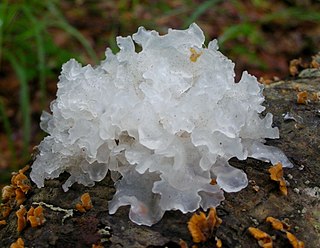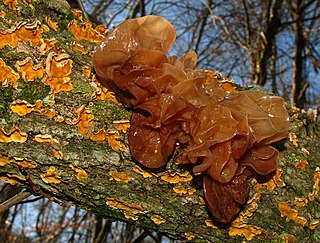
Jelly fungi are a paraphyletic group of several heterobasidiomycete fungal orders from different classes of the subphylum Agaricomycotina: Tremellales, Dacrymycetales, Auriculariales and Sebacinales. These fungi are so named because their foliose, irregularly branched fruiting body is, or appears to be, the consistency of jelly. Actually, many are somewhat rubbery and gelatinous. When dried, jelly fungi become hard and shriveled; when exposed to water, they return to their original form.

Tremella fuciformis is a species of fungus; it produces white, frond-like, gelatinous basidiocarps. It is widespread, especially in the tropics, where it can be found on the dead branches of broadleaf trees. This fungus is commercially cultivated and is one of the most popular fungi in the cuisine and medicine of China. Tremella fuciformis is commonly known as snow fungus, snow ear, silver ear fungus, and white jelly mushroom.

Nostoc is a genus of cyanobacteria found in various environments that forms colonies composed of filaments of moniliform cells in a gelatinous sheath.

Tremella mesenterica is a common jelly fungus in the family Tremellaceae of the Agaricomycotina. It is most frequently found on dead but attached and on recently fallen branches, especially of angiosperms, as a parasite of wood decay fungi in the genus Peniophora. The gelatinous, orange-yellow fruit body of the fungus, which can grow up to 7.5 cm (3.0 in) diameter, has a convoluted or lobed surface that is greasy or slimy when damp. It grows in crevices in bark, appearing during rainy weather. Within a few days after rain it dries into a thin film or shriveled mass capable of reviving after subsequent rain. This fungus occurs widely in deciduous and mixed forests and is widely distributed in temperate and tropical regions that include Africa, Asia, Australia, Europe, North and South America. Although considered bland and flavorless, the fungus is edible. Tremella mesenterica produces carbohydrates that are attracting research interest because of their various biological activities.

Pleurotus is a genus of gilled mushrooms which includes one of the most widely eaten mushrooms, P. ostreatus. Species of Pleurotus may be called oyster, abalone, or tree mushrooms, and are some of the most commonly cultivated edible mushrooms in the world. Pleurotus fungi have also been used in mycoremediation of pollutants, such as petroleum and polycyclic aromatic hydrocarbons.

Stereum hirsutum, also called false turkey tail and hairy curtain crust, is a fungus typically forming multiple brackets on dead wood. It is also a plant pathogen infecting peach trees. S. hirsutum is in turn parasitised by certain other species such as the fungus Tremella aurantia. Substrates for S. hirsutum include dead limbs and trunks of both hardwoods and conifers.

Polypodium calirhiza is a species of fern in the polypody family. Its common names include nested polypody and habit polypody. It is found in California and Oregon in the U.S., and several states of Mexico: Colima, Jalisco, Mexico State, Oaxaca, and Veracruz. The leaflets on each leaf are broad and oval-shaped, coming to a dull point. This fern is sometimes epiphytic.

Lactarius pyrogalus, commonly known as the fire-milk lactarius, is a species of inedible mushroom in genus Lactarius. It is greyish and differentiated from other grey Lactarius by its widely spaced, yellow gills. It is found on the forest floor in mixed woodland, especially at the base of hazel trees.

Bulgaria inquinans is a fungus in the family Bulgariaceae. It is commonly known by the name black bulgar and Black Jelly Drops.
Resupination is derived from the Latin word resupinus, meaning "bent back with the face upward" or "on the back". "Resupination" is the noun form of the adjective "resupine" which means "being upside-down, supine or facing upward".

Tremella is a genus of fungi in the family Tremellaceae. All Tremella species are parasites of other fungi and most produce anamorphic yeast states. Basidiocarps, when produced, are gelatinous and are colloquially classed among the "jelly fungi". Over 100 species of Tremella are currently recognized worldwide. Two species, Tremella fuciformis and Tremella aurantialba, are commercially cultivated for food.

Exidia nigricans is a jelly fungus in the family Auriculariaceae. It is a common, wood-rotting species throughout the northern hemisphere, typically growing on dead attached branches of broadleaf trees. It has been much confused with Exidia glandulosa.

Inonotus dryadeus,, commonly known as oak bracket, warted oak polypore, weeping polypore or weeping conk, is an inedible species of fungus belonging to the genus Inonotus, which consists of bracket fungi with fibrous flesh. Most often found growing at the base of oak trees, it causes white rot and decay of the trunks. It secretes an amber liquid which weeps from tubes in its upper surface.

Inocybe praetervisa is a small, yellow and brown mushroom in the family Inocybaceae, distinguished from other members of the genus by its unusual spores and bulb. The unusual spores led to the species being named the type species of the now-abandoned genus Astrosporina; recent studies have shown that such a genus could not exist, as the species with the defining traits do not form a monophyletic group. However, it is a part of several clades within the genus Inocybe. I. praetervisa grows on the ground in woodland, favouring beech trees, and is found in Europe, North America and Asia. It is inedible and probably poisonous due to the presence of muscarine. The ingestion of muscarine can lead to SLUDGE syndrome, and could potentially lead to death due to respiratory failure.

Mycena crocata is a species of agaric fungus in the family Mycenaceae. The common name saffrondrop bonnet refers to the red or orange latex that it exudes if the stipe is broken. Its habitat is woody debris and leaf litter in deciduous woodland, especially beech.

Mycena arcangeliana is a species of Mycenaceae fungus. It has been known by a number of scientific names, and its taxonomy is still somewhat disputed. It produces small mushrooms with caps varying in colour from whitish to a darker grey-brown, and stems of an olive-greyish that fade with age. The mushrooms can be mistaken for the similar Mycena flavescens. They have a mild taste, but a strong smell of iodoform; they are not edible. The species grows on dead wood in autumn months, and can be found throughout Europe.

Pleurotus citrinopileatus, the golden oyster mushroom, is an edible gilled fungus. Native to eastern Russia, northern China, and Japan, the golden oyster mushroom is very closely related to P. cornucopiae of Europe, with some authors considering them to be at the rank of subspecies. In far eastern Russia, P. citrinopileatus, they are called iI'mak, is one of the most popular wild edible mushrooms.

Leotia lubrica, commonly referred to as a jelly baby, is a species of fungus in the family Leotiaceae. The species produces small fruit bodies up to 6 centimetres (2.4 in) in height, featuring a "head" and a stalk. Ochre with tints of olive-green, the heads are irregularly shaped, while the stalk, of a similar colour, attaches them to the ground. The appearance can be somewhat variable and is similar to a number of other species, including Cudonia confusa, C. circinans, L. atrovirens and L. viscosa. L. lubrica was first validly described by Giovanni Antonio Scopoli, but it was later transferred to Leotia by Christiaan Hendrik Persoon. Its relationship with other members of the genus, of which it is the type species, is complicated.

Tremella foliacea is a species of fungus producing brownish, frondose, gelatinous basidiocarps. It is widespread, particularly in north temperate regions, and is parasitic on other species of fungi, that grow on dead attached and recently fallen branches of broadleaf trees and conifers. Common names include leafy brain, jelly leaf, and brown witch's butter. The species is said to be edible, but is not much valued.

Auricularia auricula-judae, known most commonly as wood ear or black wood ear, is a species of edible Auriculariales fungus found worldwide. The fruiting body is distinguished by its noticeably ear-like shape and brown colouration; it grows upon wood, especially elder. Its specific epithet is derived from the belief that Judas Iscariot hanged himself from an elder tree; the common name "Judas's ear" was largely eclipsed by the corruption "Jew's ear". Today, "wood ear", "jelly ear", "tree ear", and other names are sometimes used. The fungus can be found throughout the year in temperate regions worldwide, where it grows upon both dead and living wood.



















